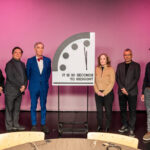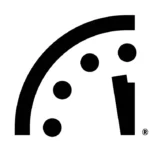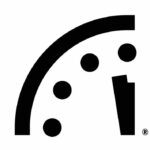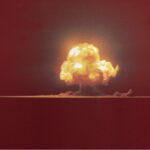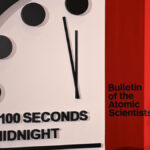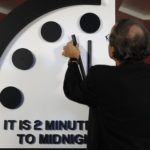Articles by Bulletin of the Atomic Scientists
We found 64 results.
Doomsday Clock Remains at 90 Seconds to Midnight
Sarah Starkey | Bulletin of the Atomic Scientists - TRANSCEND Media Service,
29 Jan 2024
23 Jan 2024 – The Doomsday Clock was reset at 90 seconds to midnight, the closest it has ever been to midnight, reflecting the unprecedented danger the world faces. The Bulletin of the Atomic Scientists emphasized that the Clock could be turned back, but governments and people needed to take urgent action.
→ read full articleAt Doom’s Doorstep: It Is 100 Seconds to Midnight
John Mecklin | Bulletin of the Atomic Scientists – TRANSCEND Media Service,
24 Jan 2022
To: Leaders and Citizens of the World
Date: 20 Jan 2022
The Doomsday Clock is set every year by the Bulletin’s Science and Security Board in consultation with its Board of Sponsors, which includes 11 Nobel laureates. The Clock has become a universally recognized indicator of the world’s vulnerability to catastrophe from nuclear weapons, climate change, and disruptive technologies in other domains.
What Are Atomic Bomb Quasicrystals, and Why Do They Matter?
Susan D’Agostino | Bulletin of the Atomic Scientists - TRANSCEND Media Service,
14 Jun 2021
9 Jun 2021 – Something unexpectedly lovely was created amid the detonation of an atomic bomb 75 years ago: a mathematically perfect quasicrystal. Quasicrystals may be able to determine responsible parties in a nuclear terrorist attack.
→ read full articleOrigin of Covid–Following the Clues: Did People or Nature Open Pandora’s Box at Wuhan?
Nicholas Wade | Bulletin of the Atomic Scientists - TRANSCEND Media Service,
10 May 2021
5 May 2021 – The COVID-19 pandemic has disrupted lives the world over for more than a year. Its death toll will soon reach three million people. Yet the origin of pandemic remains uncertain: The political agendas of governments and scientists have generated thick clouds of obfuscation, which the mainstream press seems helpless to dispel. In what follows I will sort through the available scientific facts, which hold many clues as to what happened, and provide readers with the evidence to make their own judgments.
→ read full article2021 Doomsday Clock Statement: It Is 100 Seconds to Midnight
John Mecklin | Editor - Bulletin of the Atomic Scientists,
1 Feb 2021
27 Jan 2021 – The Clock has become a universally recognized indicator of the world’s vulnerability to catastrophe from nuclear weapons, climate change, and disruptive technologies in other domains.
→ read full articleManhattan Project in Their Own Words: Trinity at 75
Bulletin of the Atomic Scientists - TRANSCEND Media Service,
20 Jul 2020
On July 16, 1945 the first nuclear bomb exploded in New Mexico.The history of the Manhattan Project and the birth of the bomb have been examined and reexamined countless times over the past seven decades—as have the threats they posed to humanity. Though nearly all now are dead, many scientists, soldiers, and family members who attended the birth of the bomb documented their first-hand experiences in the pages of the Bulletin.
→ read full articleCloser than Ever: It Is 100 Seconds to Midnight
John Mecklin | Bulletin of the Atomic Scientists – TRANSCEND Media Service,
27 Jan 2020
Doomsday Clock Statement – 23 Jan 2020 – Humanity continues to face two simultaneous existential dangers—nuclear war and climate change—that are compounded by a threat multiplier, cyber-enabled information warfare, that undercuts society’s ability to respond. The international security situation is dire, not just because these threats exist, but because world leaders have allowed the international political infrastructure for managing them to erode. (Read on…)
→ read full article2018 Doomsday Clock: It Is Now Two Minutes to Midnight
Rachel Bronson, PhD | Bulletin of the Atomic Scientists – TRANSCEND Media Service,
29 Jan 2018
25 Jan 2018 – The year just past proved perilous and chaotic, a year in which many of the risks foreshadowed in our last Clock statement came into full relief. Although the Bulletin of the Atomic Scientists focuses on nuclear risk, climate change, and emerging technologies, the nuclear landscape takes center stage in this year’s Clock statement.
→ read full articleSuing Oil Companies to Pay for Climate Change?
Seth Shulman | Bulletin of the Atomic Scientists – TRANSCEND Media Service,
9 Oct 2017
A new peer-reviewed study published in the journal Climatic Change sheds new light on fossil fuel producers’ liability. While previous research had shown that a relative handful of companies were responsible for more than 60 percent of greenhouse gases, the authors of the new study succeeded in tracing specific climate damages—including increased temperatures and sea level rise—to the products sold by individual companies such as Chevron and ExxonMobil.
→ read full articleWhen Science Brought Americans and Russians Together
Siegfried S. Hecker | Bulletin of the Atomic Scientists – TRANSCEND Media Service,
17 Apr 2017
11 Apr 2017 – The first Russian explosive device to land on US soil wasn’t delivered by a Russian missile, as Americans feared might happen throughout the Cold War. It was delivered by FedEx. The device, an explosive magnetic flux compression generator, arrived at Los Alamos National Laboratory in late 1993, shipped from the Russian Federal Nuclear Center.
→ read full articleA Better Mousetrap?
David Krieger | Bulletin of the Atomic Scientists – TRANSCEND Media Service,
27 Mar 2017
23 Mar 2017 – Albert Einstein noted, “Mankind invented the atomic bomb, but no mouse would ever construct a mousetrap.” We humans have created the equivalent of a mousetrap for ourselves. And we’ve constructed tens of thousands of them over the seven decades of the Nuclear Age.
→ read full articleA Nuclear Weapons Ban Should First Do No Harm to the NPT
Adam Mount and Richard Nephew | Bulletin of the Atomic Scientists – TRANSCEND Media Service,
13 Mar 2017
Simple additions to the text of a new ban treaty would keep it from being used as a cover for non-compliance with the existing non-proliferation regime.
→ read full articleHow US Nuclear Force Modernization Is Undermining Strategic Stability: The Burst-Height Compensating Super-Fuze
Hans M. Kristensen, Matthew McKinzie and Theodore A. Postol | Bulletin of the Atomic Scientists – TRANSCEND Media Service,
6 Mar 2017
How the United States nuclear forces modernization program has been mischaracterized to the general public as a reasonable effort to update the safety of US nuclear warheads. The reality of the program is instead an implementation of revolutionary new technologies that have serious implications for strategic stability and international perceptions of US nuclear intentions.
→ read full articleEurope Should Act Fast to Preserve the Iran Nuclear Deal
Ellie Geranmayeh – Bulletin of the Atomic Scientists,
6 Feb 2017
The Trump administration’s evolving policy on Iran has become a source of concern across the Atlantic. And that was even before National Security Advisor Michael Flynn’s declaration on Wednesday [1 Feb] that the United States was “putting Iran on notice.”
→ read full articleReality: Humanity Can’t Indefinitely Avoid Using Nuclear Weapons
Mustafa Kibaroglu – Bulletin of the Atomic Scientists,
6 Feb 2017
Even “realists” ought to realize that most leaders controlling nuclear weapons today can’t necessarily be trusted to behave rationally. The second round closes in our debate over a UN committee’s resolution that would mandate negotiations toward a treaty outlawing nuclear weapons.
→ read full articleDoomsday Clock Moves Ahead: It Is Now Two and a Half Minutes to Midnight
Bulletin of the Atomic Scientists – TRANSCEND Media Service,
30 Jan 2017
26 Jan 2017 – It is now two and a half minutes to midnight. For the first time in the 70-year history of the Doomsday Clock, the Bulletin of the Atomic Scientists’ Science and Security Board has moved the hands of the iconic clock 30 seconds closer to midnight. In another first, the Board has decided to act, in part, based on the words of a single person: Donald Trump, the new President of the United States.
→ read full articleGlobal Nuclear Power Database, 1951-2017
Bulletin of the Atomic Scientists – TRANSCEND Media Service,
16 Jan 2017
Our new data visualization puts a wealth of information on 60 years of nuclear power plant startups and shutdowns at your fingertips.
→ read full articleTo Abolish Nuclear Weapons, Strip Away Their Handsome Mask
Mustafa Kibaroglu | Bulletin of the Atomic Scientists – TRANSCEND Media Service,
16 Jan 2017
The golden age of deterrence has reached its end. Nuclear weapons, once a star player on the international stage, no longer enjoy a place in the limelight.
→ read full articleThe Real German Submarine Scandal
Victor Gilinsky | Bulletin of the Atomic Scientists – TRANSCEND Media Service,
9 Jan 2017
Israel is absorbed with a “submarine scandal” that centers on its contract with Germany. But the real scandal is that Germany supplies the submarines at all, through a loophole in the Non-Proliferation Treaty. The submarines are built to carry long-range Israeli cruise missiles armed with nuclear weapons.
→ read full articleThe Value in Activism: Reflections from the Columbia University Climate Sit-In
Nikita Perumal | Bulletin of the Atomic Scientists – TRANSCEND Media Service,
19 Dec 2016
When the status quo—in this case, the political and social power of extractive and destructive industries—is too strong to be undone on its own, it sometimes needs a push. I believe, wholeheartedly, that activism is that push. It is our way of reclaiming power, and catalyzing the policy changes that we so desperately need for a more just world.
→ read full articleWhat If Nuclear Weapons Are Used?
Victor Gilinsky – Bulletin of the Atomic Scientists,
21 Nov 2016
In the 1959 movie, On the Beach, a survivor of nuclear war asks, “If everyone was so smart, why didn’t they see this coming?” Exactly. Stop and think about what may be coming if we don’t act. Above all, when it comes to nuclear weapons, we should not allow ourselves to just drift into the future. We need to look ahead as best we can and steer in a safer direction.
→ read full articleUnited States Nuclear Forces, 2016
Hans M. Kristensen & Robert S. Norris | Bulletin of the Atomic Scientists – TRANSCEND Media Service,
31 Oct 2016
Published online: 2 March 2016
→ read full articleJust 90 Companies Are Accountable for More Than 60 Percent of Greenhouse Gases
Dan Drollette Jr | Bulletin of the Atomic Scientists – TRANSCEND Media Service,
31 Oct 2016
27 Oct 2016 – There’s a tendency to think that when it comes to climate change, we’re all equally at fault—and if everyone is to blame, then no one is to blame. But now it’s possible to identify the contributions of individual companies, thanks to the work of researchers such as Richard Heede. What he found is revealing.
→ read full articleRussian Nuclear Forces, 2016
Hans M. Kristensen & Robert S. Norris | Bulletin of the Atomic Scientists – TRANSCEND Media Service,
31 Oct 2016
Published online: 15 April 2016
→ read full articleWhy Obama Should Declare a No-First-Use Policy for Nuclear Weapons
Ramesh Thakur | Bulletin of the Atomic Scientists - TRANSCEND Media Service,
29 Aug 2016
An American no-first-use commitment would reduce the risk of nuclear war at a time when arsenals are growing and tensions are mounting, particularly in Asia
→ read full articleWhy Americans Love Drones
Julia M. Macdonald and Jacquelyn G. Schneider | Bulletin of the Atomic Scientists - TRANSCEND Media Service,
29 Aug 2016
The authors point out that if either Hillary Clinton or Donald Trump is looking to US public opinion for cues on formulating drone policy, then we can expect a continued emphasis on drones as part of US foreign policy. Why does the US public love drones?
→ read full articleMissile Proliferation—And Ideas That Might Work
Waheguru Pal Singh Sidhu | Brookings India Center - Bulletin of the Atomic Scientists,
11 Jul 2016
Missiles pose at least three sets of challenges to international peace and security, and creating a global regime to control or eliminate nuclear-capable missiles is easier said than done. Is it too late for missile nonproliferation?
→ read full articleThe Double-Edged Sword: US Nuclear Command and Control Modernization
Andrew Futter | Bulletin of the Atomic Scientists – TRANSCEND Media Service,
4 Jul 2016
Keeping the nuclear command and control system simple, separate, and secure may not seem very sexy in today’s digital world of extraordinary technological advance, but it might be the best way to minimize miscalculation, accidents, and even unauthorized use of nuclear weapons.
→ read full articleIt’s Time for Transparency in the US Lethal Drone Program
Rachel Stohl | Bulletin of the Atomic Scientists – TRANSCEND Media Service,
20 Jun 2016
Civilian casualties have raised a number of legal and ethical questions regarding use of this technology, particularly outside of active combat zones. Central to this debate is the secrecy surrounding the US lethal drone program, including a lack of official information on casualty figures and accountability for mistakes.
→ read full articleChernobyl Fatalities and the Challenges of Expert Judgment
Sonja Schmid – Bulletin of the Atomic Scientists,
16 May 2016
As the uncertainty over Chernobyl’s death toll illustrates, “scientific opinion” is not always unanimous, and neither is “expert judgment.” Scientific expertise is not immune to controversy. And expert judgment changes over time.
→ read full articleThe Value in Activism: Reflections from the Columbia University Climate Sit-In
Nikita Perumal – Bulletin of the Atomic Scientists,
16 May 2016
I know—I have seen—the transformative power that climate justice activism can have both on Columbia’s campus and internationally. When the status quo—in this case, the political and social power of extractive and destructive industries—is too strong to be undone on its own, it sometimes needs a push. I believe, wholeheartedly, that activism is that push.
→ read full articleIt Is Still 3 Minutes to Midnight
Bulletin of the Atomic Scientists – TRANSCEND Media Service,
2 May 2016
The Doomsday Clock is an internationally recognized design that conveys how close we are to destroying our civilization with dangerous technologies of our own making. First and foremost among these are nuclear weapons, but the dangers include climate-changing technologies, emerging biotechnologies, and cybertechnology that could inflict irrevocable harm, whether by intention, miscalculation, or by accident, to our way of life and to the planet.
→ read full articleNuclear Emergencies and the Masters of Improvisation
Sonja Schmid – Bulletin of the Atomic Scientists,
2 May 2016
April 26 marks the 30th anniversary of the Chernobyl disaster, and those old enough to remember the event can recall the explosion, the evacuation, and the dread. But they rarely remember an immense milestone in the response to the disaster: the completion in November 1986 of a concrete encasement of Chernobyl’s reactor number four. Workers drawn from all across the Soviet Union built this “sarcophagus” under extreme radiological conditions, on the ruins of the destroyed reactor.
→ read full articleLearning from Nuclear Accidents, Expanding Nuclear Energy
Augustin Simo – Bulletin of the Atomic Scientists,
2 May 2016
The Chernobyl disaster of 1986 was caused by factors including a flawed reactor design, insufficient training of plant operators, and a lack of nuclear safety culture.
→ read full articleWhat Does “Nuclear Terrorism” Really Mean?
Elisabeth Eaves – Bulletin of the Atomic Scientists,
18 Apr 2016
There are few scarier pairs of words: “nuclear,” evoking the great 20th century fear of atomic annihilation, and “terrorism,” the bogeyman of the 21st. Put them together and you’ve got a frightening specter.
→ read full articleNuclear Security: Continuous Improvement or Dangerous Decline?
Matthew Bunn, Martin B. Malin, Nickolas Roth and William Tobey - Bulletin of the Atomic Scientists,
4 Apr 2016
The answer will shape the chances that terrorist groups, including the Islamic State, could get their hands on the materials they need to build a crude nuclear bomb. In a report (pdf file) we published late in March, we outline the shape of the threat and the steps that must be taken to keep potential nuclear bomb material out of terrorist hands.
→ read full articleContaminated Nuclear Weapons Sites
Robert Alvarez – Bulletin of the Atomic Scientists,
22 Feb 2016
West Lake Story: An Underground Fire, Radioactive Waste, and Governmental Failure
→ read full articleClimate Protection through Nuclear Power Plants? Hardly
Lutz Mez – Bulletin of the Atomic Scientists,
22 Feb 2016
From a systemic perspective, nuclear power plants are by no means free of carbon dioxide emissions. Today, they produce up to one third of the greenhouse gases that large modern gas power plants produce.
→ read full articleDoomsday Clock Hands Remain Unchanged, Despite Iran Deal and Paris Talks
Bulletin of the Atomic Scientists – TRANSCEDEND Media Service,
1 Feb 2016
January 26, 2016 – The Bulletin of the Atomic Scientists Science and Security Board announced today that the minute hand of its closely watched Doomsday Clock will remain at three minutes to midnight, since recent progress in the Iran nuclear agreement and the Paris climate accord “constitute only small bright spots in a darker world situation full of potential for catastrophe.”
→ read full articleNuclear Expert Siegfried Hecker Assesses North Korean Hydrogen Bomb Claims
Steve Fyffe, Stanford Center for Int’l Security and Cooperation – Bulletin of the Atomic Scientists,
11 Jan 2016
7 Jan 2015 – One of the world’s top experts on the North Korean nuclear program, former Los Alamos National Laboratory director Siegfried Hecker has visited North Korea seven times since 2004; he is one of the few Western scientists to have set foot inside the Yongbyon nuclear facility.
→ read full articleArms-Control Lessons from the Volkswagen Scandal
Moritz Kütt – Bulletin of the Atomic Scientists,
14 Dec 2015
Volkswagen got away with this legerdemain for years because, like most carmakers, it uses proprietary software to control its engines and other systems, software that still is not available to vehicle inspectors or independent analysts. Arms-control verification relies on similarly complex combinations of software and hardware, and verification tools often use proprietary or export-controlled technology that prevents transparency and independent scrutiny.
→ read full articleIs Artificial Intelligence Really an Existential Threat to Humanity?
Edward Moore Geist – Bulletin of the Atomic Scientists,
17 Aug 2015
With intellectual powers beyond human comprehension, Oxford University philosopher Nick Bostrom prognosticates, self-improving artificial intelligences could effortlessly enslave or destroy Homo sapiens if they so wished.
→ read full articleJapan: Why Was the Sendai Nuclear Power Plant Restarted?
Tadahiro Katsuta – Bulletin of the Atomic Scientists,
17 Aug 2015
The decision is probably based on the “dismal science” of economics, not safety. The justification for a restart was based upon three key points. Let us look at each of these items in turn.
→ read full articleShould Nuclear Devices Be Used to Stop Asteroids?
Seth Baum – Bulletin of the Atomic Scientists,
22 Jun 2015
Given that asteroids and comets pose a significant risk of a low-probability extreme catastrophe, and given that the alternative means of deflecting them do not work as well, an anti-NEOs (near-Earth objects) nuclear stockpile merits serious consideration.
→ read full articleIn Imitation of Christ: Pope Francis’ Encyclical on Climate Change
Celia Deane-Drummond – Bulletin of the Atomic Scientists,
22 Jun 2015
Small yet strong in the love of God, like Saint Francis of Assisi, all of us, as Christians, are called to watch over and protect the fragile world in which we live, and all its peoples
→ read full articleIs Stratospheric Geoengineering Worth the Risk?
Seth Baum – Bulletin of the Atomic Scientists,
15 Jun 2015
There is at least one way that stratospheric geoengineering could be even more dangerous than regular global warming.
→ read full articleNuclear Fuel Cycle Cost Calculator
Robert Rosner, Jeremy Klavans and Sam Olofin – Bulletin of the Atomic Scientists,
8 Jun 2015
Discussions of the future of nuclear power often focus on safety, proliferation, waste storage, and carbon emissions – accepting cost as a given. This tool breaks the cost of investing in nuclear power into its component parts and considers the price of three configurations of the ‘fuel cycle.’
→ read full articleThe Non-Proliferation Treaty Review Conference
Bulletin of the Atomic Scientists – TRANSCEND Media Service,
4 May 2015
28 Apr 2015 – The NPT Review Conference is taking place from now until May 22 in New York City. Adam Mount explains what it is and how this year’s conference is likely to be a dismal failure.
→ read full articleSafety—The Overlooked Crucial Issue in Iranian Nuclear Negotiations
Ariane Tabatabai – Bulletin of the Atomic Scientists,
20 Apr 2015
Nuclear safety is about preventing and mitigating accidents, and making sure that nuclear facilities operate properly and don’t pose a radiation hazard to people or places. It is not a sexy topic. But along with proliferation, it is one of the most pressing issues to consider in the context of any nuclear program.
→ read full articleWhat Would Happen If an 800-Kiloton Nuclear Warhead Detonated above Midtown Manhattan?
Steven Starr, Lynn Eden & Theodore A. Postol – Bulletin of the Atomic Scientists,
23 Mar 2015
After one second, the fireball would be roughly a mile in diameter. It would have cooled from its initial temperature of many millions of degrees to about 16,000 degrees Fahrenheit, roughly 4,000 degrees hotter than the surface of the sun.
→ read full articleThe Myth of Biological Weapons as the Poor Man’s Atomic Bomb
Gregory D. Koblentz – Bulletin of the Atomic Scientists,
23 Mar 2015
In his recent column, “Deterrence, without nuclear winter,” Seth Baum concludes that non-contagious biological weapons are one of two viable alternatives to replacing nuclear weapons in order to achieve what he calls “winter-safe deterrence.”
→ read full articleDoomsday Clockwork
Kennette Benedict – Bulletin of the Atomic Scientists,
16 Mar 2015
Over the last 68 years, the Bulletin has reset the minute hand on the Doomsday Clock 21 times, most recently this year when we moved it from five minutes to midnight to three. Every time it is reset, we’re flooded with questions about the internationally recognized symbol. Here are answers to some of the most frequent queries.
→ read full articleNuclear Notebook, the Interactive Edition
Bulletin of the Atomic Scientists – TRANSCEND Media Service,
9 Mar 2015
At the click of a mouse, our new multimedia presentation tracks world nuclear arsenals over seven decades.
→ read full articleOut of the Nuclear Shadow: Scientists and the Struggle against the Bomb
Zia Mian – Bulletin of the Atomic Scientists,
9 Mar 2015
Mian argues that absent an aroused and insistent public demanding an end to nuclear weapons, which the early scientists believed was necessary to curb the nuclear danger, the prospects for nuclear disarmament in the foreseeable future appear grim. He concludes: “This is where the scientist has to step aside and the citizen has to step forward.”
→ read full articleWhere Does Iran’s Supreme Leader Really Stand on Nuclear Negotiations?
Ariane Tabatabai – Bulletin of the Atomic Scientists,
23 Feb 2015
“Not reaching a deal would be better than a bad deal.” – Khamenei. This moment is a unique opportunity for Iranian negotiators to make a comprehensive deal they can sell to domestic hardliners, using the momentum provided by the country’s highest political authority.
→ read full articleTimeline: The IPCC’s Shifting Position on Nuclear Energy
Suzanne Waldman - Bulletin of the Atomic Scientists,
16 Feb 2015
The Intergovernmental Panel on Climate Change (IPCC) was formed in 1988 as an expert panel to guide the drafting of the United Nations Framework Convention on Climate Change, ratified in Rio de Janeiro in 1992. The treaty’s objective is to stabilize greenhouse gases in the atmosphere at a safe level.
→ read full articleIt Is 3 Minutes to Midnight in the Doomsday Clock
Bulletin of the Atomic Scientists – TRANSCEND Media Service,
26 Jan 2015
23 Jan 2015: Unchecked climate change and the nuclear arms race have pushed the minute hand of the Doomsday Clock forward to three minutes closer to midnight, announced in Washington DC members of the Bulletin of the Atomic Scientists, the body behind the calculations and creation of the Clock of Doom in 1947.
→ read full articleThe Struggle to Ban Killer Robots
Kristin Bergtora Sandvik, Nicholas Marsh and Maral Mirshahi – Bulletin of the Atomic Scientists,
26 May 2014
The campaign must balance technical expert conversations with active participation in public debate. Identifying and arguing for broad ethical principles while keeping the objective narrow appears to be the most feasible strategy, along with insisting that the development of lethal autonomous weapons is not inevitable.
→ read full articleThe WIPP-Waste Isolation Pilot Plant Problem, and What It Means for Defense Nuclear Waste Disposal
Robert Alvarez – Bulletin of the Atomic Scientists,
31 Mar 2014
“It’s a surprise when there are no surprises,” a cleanup worker told me a few years ago at the Hanford site in Washington state, once the world’s largest producer of plutonium for nuclear weapons and now home to a massive effort to stop leaking nuclear waste tanks from poisoning the Columbia River.
→ read full articleFive Minutes Is Too Close
Bulletin of the Atomic Scientists – TRANSCEND Media Service,
20 Jan 2014
From: The Bulletin of the Atomic Scientists Science and Security Board.
To: United Nations Secretary-General Ban Ki-Moon, members of the UN Security Council.
Re: It is still five minutes to midnight.
The Doomsday Clock
Bulletin of the Atomic Scientists – TRANSCEND Media Service,
21 Jan 2013
21 Jan 2013: IT IS FIVE MINUTES TO MIDNIGHT – The Doomsday Clock conveys how close humanity is to catastrophic destruction–the figurative midnight–and monitors the means humankind could use to obliterate itself. First and foremost, these include nuclear weapons, but they also encompass climate-changing technologies and new developments in the life sciences that could inflict irrevocable harm.
→ read full articleDoomsday Clock Moves to Five Minutes to Midnight
Science and Security Board, The Bulletin of the Atomic Scientists – TRANSCEND Media Service,
16 Jan 2012
It is five minutes to midnight. Two years ago, it appeared that world leaders might address the truly global threats that we face. In many cases, that trend has not continued or been reversed. For that reason, the Bulletin of the Atomic Scientists is moving the clock hand one minute closer to midnight, back to its time in 2007.
→ read full articleThe Road Not Taken: Can Fukushima Put Us on a Path toward Nuclear Transparency?
Kennette Benedict – Bulletin of the Atomic Scientists,
27 Jun 2011
The disaster at the Fukushima Daiichi nuclear power station is a sobering reminder that nuclear power relies on the most dangerous technology on Earth. Despite victories like the creation of the Atomic Energy Commission, and later the Nuclear Regular Commission, the secrecy that began with the Manhattan Project has tended to permeate the civilian nuclear program, as well as the military and defense programs.
→ read full articleThe Lessons of Fukushima
Hugh Gusterson – Bulletin of the Atomic Scientists,
4 Apr 2011
This leaves us with a choice between walking back from a technology that we decide is too dangerous or normalizing the risks of nuclear energy and accepting that an occasional Fukushima is the price we have to pay for a world with less carbon dioxide. It is wishful thinking to believe there is a third choice of nuclear energy without nuclear accidents.
→ read full article